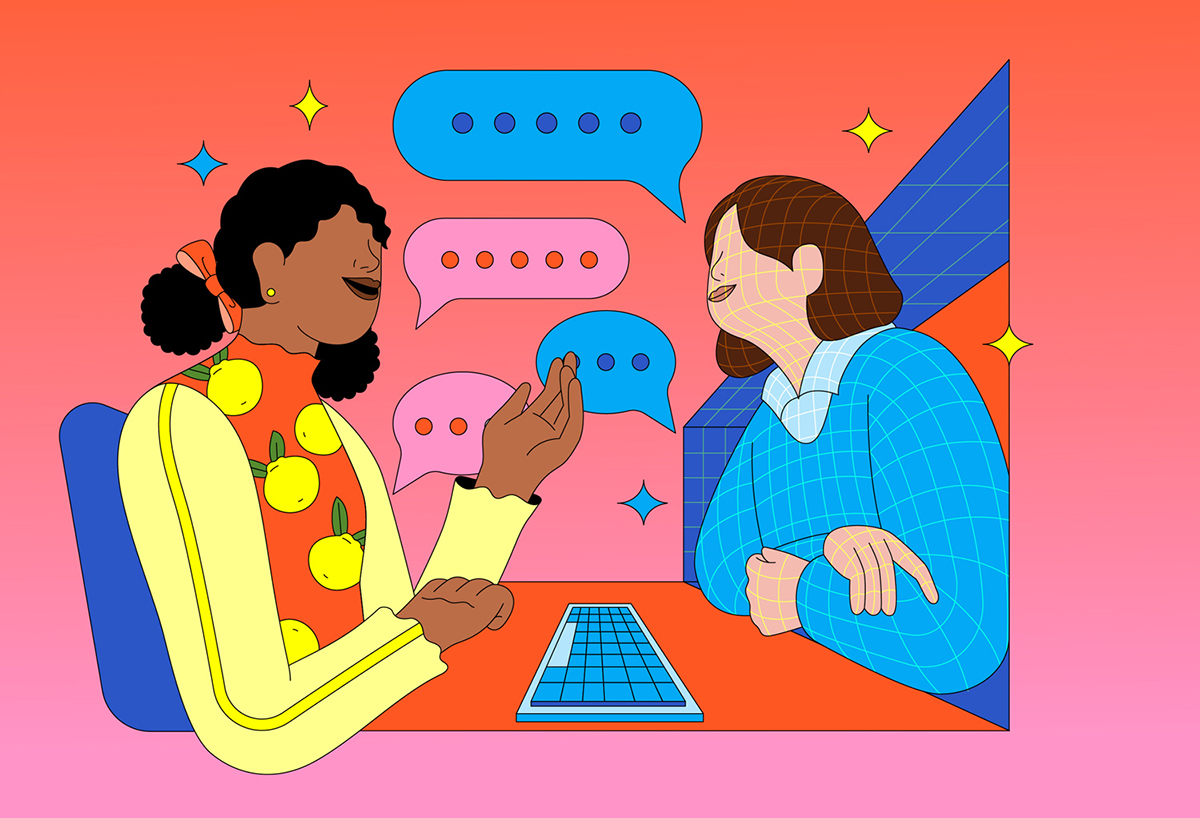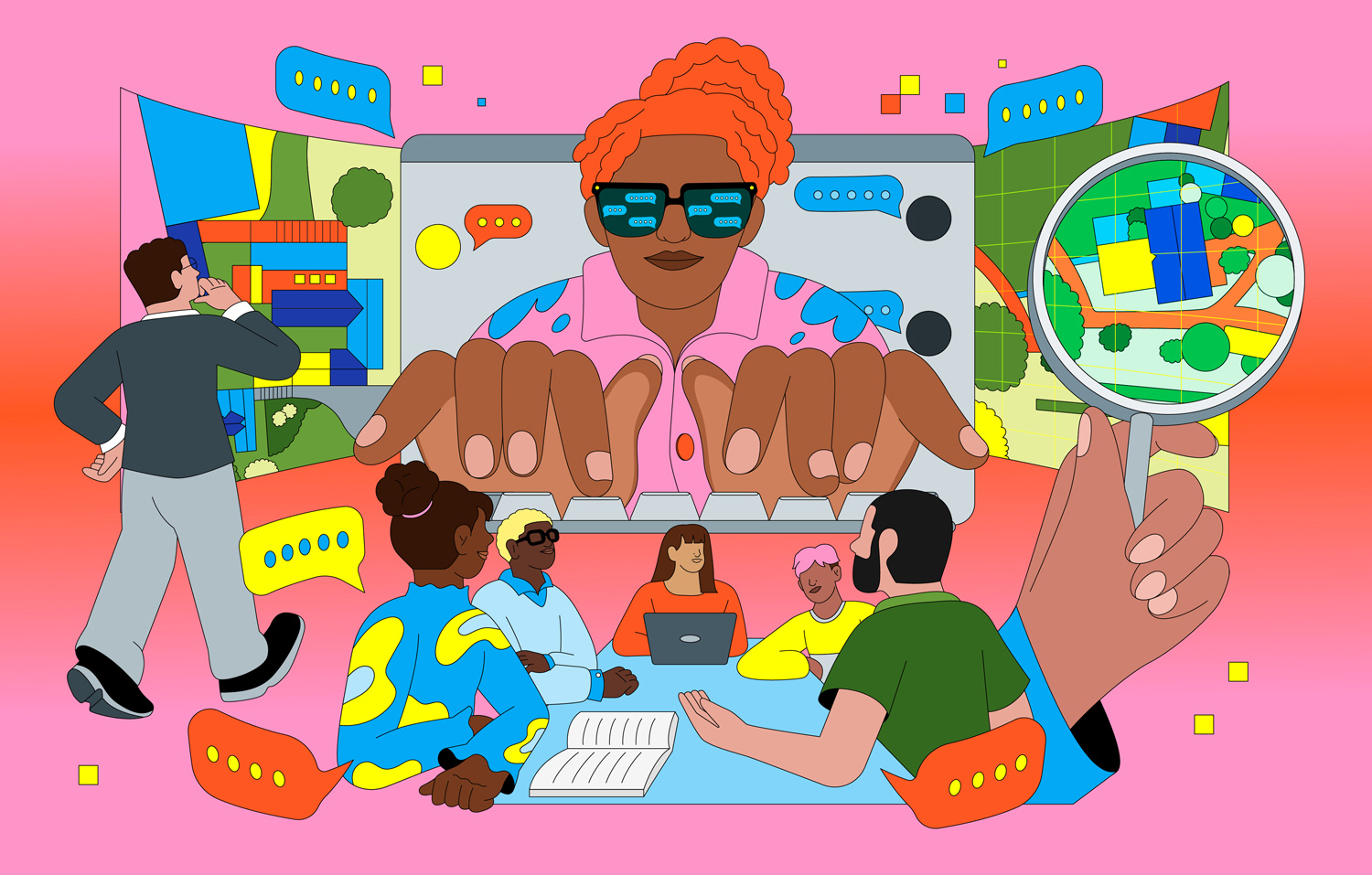As a student in a third-year computer science course at U of T Mississauga earlier this year, Valeria Ramirez-Osorio was able to turn for academic help to a new, approved “member” of the teaching team: an AI chatbot.
QuickTA was on hand 24-7 to answer Ramirez-Osorio’s questions about topics such as relational algebra, computer programming languages and system design. It was able to summarize complex definitions, explain concepts and generate computer code. Trained on the course curriculum and based on the AI language model of ChatGPT, it was able to respond to her queries in a conversational way. Ramirez-Osorio says QuickTA was invaluable in helping her complete assignments and prepare for tests – most of the time. “It was very impressive. It was well formatted and easy to understand. Me and my friends, we used it a lot for studying,” she says. But it did have limitations: “The only time it let me down is when I asked it something too specific.”
The introduction of QuickTA was sparked by the emergence last November of ChatGPT, the wildly popular chatbot that can process, understand and generate written language in a way that seems similar to humans. ChatGPT can answer questions, compose essays and stories, summarize long texts, translate from one language to another, generate computer code – all with results that are frequently (but not always) accurate and relevant.
Attracting 100 million users in its first two months, the free web-based tool has been shaking up diverse domains such as marketing, media, and customer service. In higher education, the technology has sparked deep reflection about teaching methods, evaluation formats and academic integrity. Some institutions have restricted or outright banned it.
“The significance of this technology is potentially quite large,” says Susan McCahan, U of T’s vice-provost of academic programs and of innovations in undergraduate education. “I think we are just starting to scratch the surface of what it means.”
Charged with guiding human-AI interaction at U of T, McCahan says she spent most of her winter break last year studying the ChatGPT phenomenon and its implications for teaching, learning and other key functions at the institution. Together with several colleagues, she determined that new policies on AI were unnecessary, but that guidance for faculty and students was needed.
By the end of January, they had developed a list of FAQs on the use of ChatGPT and generative AI in the classroom, making U of T one of the first Canadian universities to do so. The document, which is revised regularly to keep pace with changing technology, covers topics such as whether instructors can use AI in their teaching (yes, with caution: the university discourages the use of public tools it hasn’t vetted for privacy and security); whether students can use it to complete assessments (no, unless specified otherwise by their instructor); and the tool’s reliability (on occasion, it produces content that is inaccurate or biased).
“One of the important things for instructors is to have a conversation with students about their expectations on how ChatGPT and generative AI can – or should not – be used in class,” McCahan says. She suggests instructors could help students understand their role when working with AI systems as the “human in the loop” – a term that refers to the primacy of human judgment in guiding the safe and responsible use of AI, and knowing when and how to override the technology when it fails.
As part of her research into the technology, McCahan convened a meeting on ChatGPT with her counterparts at 14 other research universities in Canada, and established an advisory group at U of T on teaching and learning.
ChatGPT’s meteoric rise also prompted McCahan’s office to extend funding for projects exploring how generative AI could be used in teaching. QuickTA was one such project, with Michael Liut, an assistant professor of computer science, piloting the intelligent digital tutor he co-developed to determine if it could provide timely and high-quality academic support to his students. (The tool gives accurate responses about 90 per cent of the time). Once it’s optimized, he says, it could be especially useful in his first-year Introduction to Computer Science course, which can attract 1,000 students – a number that taxes the capacities of his 54-person teaching team.
“What I was focusing on was the mass scale. With a big class, we can’t give enough personalized help,” says Liut, whose invention recently won an AI Tools for Adult Learning competition in the U.S. “I realized that we could use this generative AI to give students personalized, unique support when they need it.”

It’s not just written communication that is being reshaped by generative AI. Several similar tools now make it possible to create new image, audio and video content. In another U of T-supported project, Zhen Yang, a graduate student at the John H. Daniels Faculty of Architecture, Landscape, and Design, is creating a guide for first-year students that focuses on the differences between traditional and AI image research methods and helps them use AI ethically. He says the materials will highlight issues around obtaining permissions when using AI tools.
U of T Scarborough, meanwhile, is using AI to help arts and science co-op students prepare for the workforce. In 2022, the co-op department introduced an application called InStage, which lets students engage with human-like avatars to practise job interviews. The application is tailored to the curriculum of two co-op courses, so the avatars are able to ask appropriate questions and provide meaningful feedback. The app also tracks metrics such as the students’ eye contact, the length and speed of their responses, and the number of times they say “um.” The initiative is now being expanded to two groups that face barriers to employment: international students and students with disabilities.
Cynthia Jairam-Persaud, assistant director of student services at U of T Scarborough, says the tool is not meant to replace interactions between students and co-op staff. “We looked at it as a way of enabling students to practise repeatedly and get immediate feedback,” she says. “It also gives co-ordinators something tangible to coach students on.”
McCahan says while U of T continues to find its footing in the still-evolving AI technology landscape, there is now growing enthusiasm among community members to explore its potential for innovating in education.
“After coming through the pandemic and having to change everything they did in all kinds of ways, I think our faculty were thinking, ‘Oh my goodness, we have to change all kinds of things again,’” McCahan says. But the mood appears to have calmed: “Many of us have lived through the advent of personal computers, the internet and Wikipedia. Now it’s more like, ‘Here we go again.’”
Recent Posts
People Worry That AI Will Replace Workers. But It Could Make Some More Productive
These scholars say artificial intelligence could help reduce income inequality
A Sentinel for Global Health
AI is promising a better – and faster – way to monitor the world for emerging medical threats
The Age of Deception
AI is generating a disinformation arms race. The window to stop it may be closing






One Response to “ Education Is Evolving in the Age of AI ”
How all this will affect middle and senior schools is another big question. The teaching methodology there has traditionally been governed by university practice, i.e. teaching lessons to classes. Absenteeism and disengagement have been huge deficits in that model from the start. For students to always do the teacher's work is disengaging. Doing one's own work is very engaging. Now we have to add serious anxieties and stress. So is the exercise now how to help the teachers cope or to help the students learn?